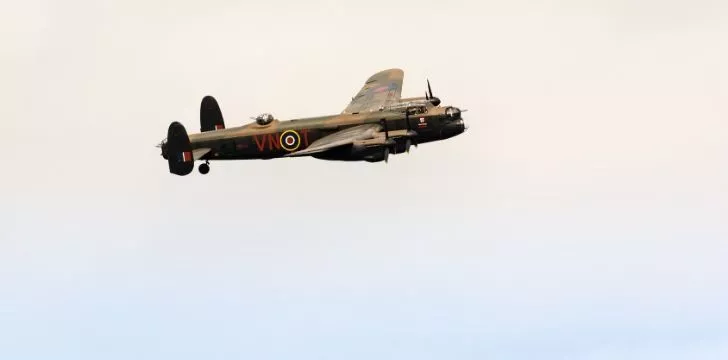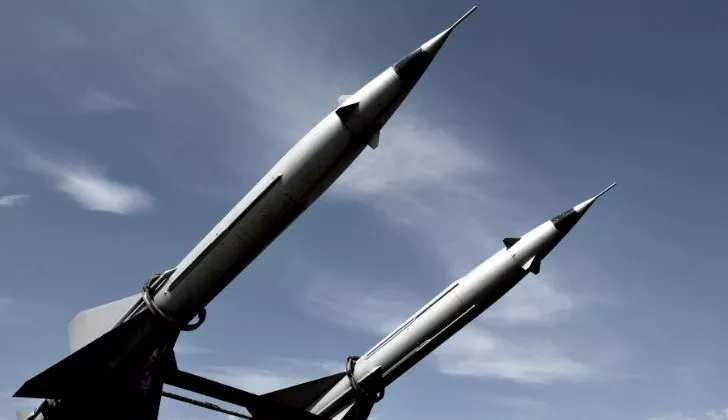Ever since Oppenheimer beheld his explosive herald of the new world and waxed lyrically Shiva, it’s fair to say people have always had the niggling thought of impending nuclear doom at the back of their heads.
Sometimes it’s been something more at the forefront of the collective consciousness.
Whether you’re worrying about Kim Jong-un’s tiny rockets or Khrushchev’s winter-producing arsenal, we all know what it’s like to fear a nuclear holocaust.
So, with all the world’s nuclear posturing and flexing over the years, it should come as no surprise that the planet has nearly been enveloped in the start of a nuclear war a few times over.
And that’s what the purpose of today’s article is: three times the world nearly broke out into nuclear war, either accidentally or purposefully.
A Faulty Trigger – The North Carolina Incident, January 1961

Ah the 60’s, the decade of free love and the Cold War. Somewhat of an oxymoronic decade, really.
Besides The Beatles and Woodstock, the ’60s gave us some other things that are also still here, such as the saying “make love not war,” or the phrase “mutually assured destruction” (I personally prefer the amalgamation of the two into: “make love not mutually assured destruction”).
It’s safe to say favoring nuclear war, retaliation, and holocaust were all popular mindsets among both the Eastern and Western governments of the time, especially among the American Generals who had pushed for dropping the third bomb on Japan after their surrender.
Not to mention the other 9 bombs that the US government had created for “resolving” the Pacific conflict.
So with that little bit of contextual prose out of the way, it should really come as no surprise that during the ’50s, ’60s, ’70s, and ’80s, the U.S. constantly had bombers and jets carrying nuclear bombs in the air to respond to a nuclear attack by the Soviet Union.
The thinking behind this being “well they might destroy our country, but they can’t destroy the sky so we’ll keep some bombs there, just in case.” Mutually assured destruction indeed.
On the 24th of January, 1961, just four days after JFK’s inauguration, a B-52G Stratofortress jet bomber was flying over Goldsboro in North Carolina, loaded up with a pair of Mark 39 3.8-megaton hydrogen bombs.
To put that into perspective, each of the two bombs were roughly 260 times more powerful than either of the bombs dropped on Hiroshima and Nagasaki.
Around midnight on the 23rd of January, the bomber was scheduled to undergo a mid-air refueling, a routine procedure even back then, when the refueling crew noticed that the bomber’s right wing was leaking fuel so the refueling operation was called off.
The fault wasn’t necessarily a problem, as it was a fairly safe assumption that the bomber could continue to function whilst making its way to a safe landing zone.
However, after being redirected to Seymour Johnson Air Force Base, the crew of eight lost control of the plane.
The Stratofortress lost its wing, then its tail, and then started to spin wildly out of control.
Pilot Adam Mattocks ordered his crew to bail out and made the jump to safety along with four other crew members.
The three other crew members sadly perished in the accident.
The plane smashed nose-first into a tobacco field about 60 miles east of Raleigh, setting the ground ablaze.
However, as the bomber had spiraled down its bomb-bay doors had opened, throwing the two nuclear weapons out into the night, rushing down to meet the ground.
One of the bombs deployed its parachute, making a safe landing in a tree. This bomb’s arming switch had been kept in the “safe” position, so there was zero chance it would have gone off.
The other bomb, however… well, let’s just say the other bomb was difficult.
During the fall its parachute had failed, so when it hit the ground it broke up into so many pieces that it took the responders seven days to find all the different parts.
Even more remarkable, though, was the fact it didn’t literally go nuclear. A nuclear bomb has seven steps towards detonation, and this particular bomb had gone through six of them. Its arming switch was active and set to “arm,” but it just didn’t explode – and nobody knows why.
Also equally unsettling, despite the fact that the bomb’s primary uranium core was found its secondary core is still missing even to this day.
The government believes that it’s still buried somewhere at the crash site up to 60 meters below the ground, but there doesn’t seem to be any radiation risk to the locals from the lost core so there’s not a particularly big worry to find it.
Thankfully the bomb never blew, because if it had then it is estimated 28,000 people would have been vaporized, and a further 26,000 injured, not to mention those that would have been affected by 30-mile radiation cloud which would have spread out over the area.
Only declassified in 2014, this incident serves to remind the world just how close were to the onset of nuclear war.
Defiance In The Face Of Fear – Vasili Arkhipov, October 1962

During the height of the Cuban Missile Crisis, as the world watched on with baited breath and radiation masks at the ready, 11 U.S. Navy destroyers and the aircraft carrier USS Randolph had located the diesel-powered, nuclear-armed Soviet Foxtrot-class submarine B-59 underneath the waves near Cuba.
Despite being in international waters, Team America started dropping depth charges on the B-59, trying to force it to surface for identification.
Aboard the B-59 were three nuclear action decision-makers; Captain Valentin Grigorievitch Savitsky, Political Officer Ivan Semonovich Maslennikov, and Second-In-Command Vasili Arkhipov.
For the submarine’s nuclear armament to be used, all three of these key decision-makers had to agree in unison.
Typically, Russian submarines armed with a “Special Weapon” only required a Captain to gain authorization from the Political Officer to fire, but as Vasili Arkhipov was commander of the flotilla to which the B-59 belonged, the launch of any nuclear weapons from the B-59 required unanimous approval from the three officers.
There had been no radio contact to the submarine from Moscow for days and, despite the fact that the submarine crew had been picking up U.S. civilian radio broadcasts, the B-59’s radios went completely dark as they dove deeper to avoid the depth charges of the U.S. Navy.
As they were trapped in their potential watery coffin deep beneath the waves in international waters, being rocked and rolled by the boom of explosions around them, an argument broke out onboard between the three officers.
Captain Savitsky was adamant war had already broken out which was why the Americans were attacking them in international waters, and that the only course of action was to retaliate with a nuclear torpedo.
Political Officer Maslennikov also agreed with the Captain, believing the time had come for the crew to unleash their payload.
At this point, the submarine’s batteries had run very low and the air conditioning had failed, causing extreme mechanical heat and high levels of carbon dioxide inside the submarine.
This meant that the already heated tempers began to flare up even more.
Despite the protestations of the two other officers, and not knowing whether war had broken out on the surface, Vasili Arkhipov refused to give the order to fire the nuclear torpedo – he didn’t bend even the slightest bit.
The defiant Flotilla Commander stood strong and kept his resolve, eventually talking Captain Savitsky down and convincing him to surface and await orders from Moscow.
So that’s what they did; they surfaced amidst their American pursuers and returned home to their beloved and living Soviet Union with their tail between their legs and no nuclear holocaust on their hands.
Upon returning to the Soviet Union, the defiant hero who saved the world and all of his crew were greeted with disgust and disgrace by their superior officers.
One Admiral even told them “It would have been better if you’d gone down with your ship.”
Although Vasili and his crew were viewed as villains at the time, later on when the truth about the incident surfaced people worldwide gave Vasili the recognition he truly deserved, hailing him not as a failure who should have sunk with his ship, but as the hero who stopped the nuclear war from happening.
The Foibles Of Technology – Stanislav Petrov, September 1983

In September 1983, during the height of the Cold War, Stanislav Petrov was on duty at a Soviet Union military facility that specialized in the early detection of incoming missiles from the U.S.
Working a regular and routine shift at his consoles in the early hours of the morning on September 26th, Stanislav suddenly spotted something terrifying.
A handful of U.S. nuclear missiles were flying towards Russia.
He checked the computers at his disposal, rechecked them, then triple-checked them just to make sure.
All results gave the same reading: this was it, this was the nuclear strike he had been trained to look out for, this was the nuclear strike the world had been nervously anticipating ever since the end of World War II.
Stanislav refused to believe what the instruments and readings were showing them, disbelieving that the Americans would do this.
He made a decision, going against all his training and installed sense of military duty, that these were false readings and chose to dig into them deeper rather than reporting them to his superiors.
In an interview from 2013 with the BBC, Stanislav said
“I had all the data [to suggest there was an ongoing missile attack]. If I had sent my report up the chain of command, nobody would have said a word against it. All I had to do was to reach for the phone; to raise the direct line to our top commanders – but I couldn’t move. I felt like I was sitting on a hot frying pan.”
All of Stanislav’s training dictated that he should have contacted the Soviet military officers immediately, informing them of the incoming threat so they could brace for the impact and order a retaliation.
Instead, he called the Duty Officer at the army headquarters and reported a system malfunction – a direct and serious dereliction of duty.
Stanislav wasn’t without his doubts, however.
As well as monitoring for incoming missiles, the Soviet Union was also monitoring America’s missile launch sites, and a quick call during Stanislav’s checks proved that no activity had been monitored at these missile sites.
Had this roll of the dice not been in his favor, the first of the perceived nuclear blasts would have happened only minutes later.
“Twenty-three minutes later I realized that nothing had happened. If there had been a real strike, then I would already know about it. It was such a relief.” Stanislav recalled to the BBC.
A later investigation into the incident revealed that the Soviet surveillance satellites which the system relied on had mistakenly identified sunlight reflected on clouds as the engines of intercontinental ballistic missiles.
Later on, Stanislav is still unwilling to admit that he was absolutely sure the readings were wrong.
Afterwards he kept his silence for 10 years until the collapse of the Soviet Union, after which he went public with the information and was credited with several international awards.
As the best heroes often are, Stanislav was incredibly modest about the situation, saying he was no hero for it: “That was my job, but they were lucky it was me on shift that night”.
For the sake of some sunlight mistaken by Soviet satellites, the Cold War nearly got very hot.
However, for the sake of a cool head Stanislav Petrov chose not to call the superiors and trigger a domino-fall series of events which would have led to a full-scale Russian nuclear bombardment of America and very possibly mainland Europe.
Stanislav Petrov retired at the rank of Lieutenant Colonel, and later died of old age at 77, living a full life in a living world that he partly bears the responsibility for.
So there you have it, three times a nuclear war was ever-so-narrowly avoided.
If not for a faulty trigger, a defiant commander, or a quizzical analyst, we’d all be joining the Brotherhood of Steel or trying to make it in the radiated wastelands of a Fallout game.

















